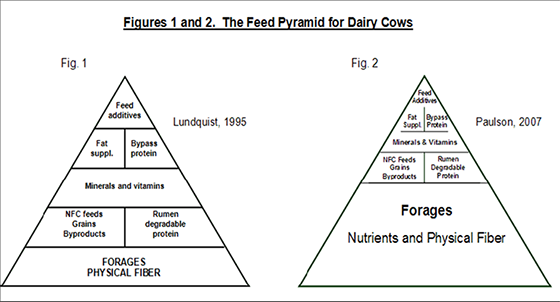
Today’s nutritional technology and knowledge make it easy to overlook the basics of dairy cow nutrition. This, in turn, makes it possible to complicate a ration with the inclusion of too many commodities. Don’t forget the basics. Dairy cows require nutrients and not feed ingredients. For example:
Therefore, forage should be considered the base of all dairy rations (Figures 1 and 2). In recent years, the forage base has been given more importance when considering the feed pyramid for dairy cows. The rumen is a fermentation vat and forage maintains a stable rumen environment for the rumen microbes. Forage also forms the rumen mat which contains effective fiber that stimulates rumination. Rumination leads to saliva production that provides sodium bicarbonate to buffer rumen acids, as well as a source of sodium, and provides urea which is used as a soluble nitrogen source by rumen microbes. Feeding forage leads to:

If the focus is on forage for the base in dairy rations then the forage produced should be high quality. Management is the key to producing quality forage which will be the most economical source of nutrients on the farm.

The rumen microbes need:
All of these nutrients can be found in forage and become more available to the rumen environment with quality forage.
The cow needs:
By focusing on the rumen first we dedicate dietary ingredients to optimizing rumen function. This means we feed to optimize rumen microbial growth which leads to improved feed digestion in the rumen and optimal microbial protein flow to the intestine. We need to remember that microbial protein can supply 50 to 80% of the cow’s daily protein requirement which contains the most adequate amino acid profile available to the cow. If we optimize rumen function additional ingredients needed to feed the cow can be minimized (a simpler diet).
“Make your primary sources of fermentable carbohydrates high-quality forages and fine ground or steam-flaked cereal grains. This will maximize microbial protein production as microbial protein has a superior amino acid profile to rumen un-degradable protein (RUP).”
Dr. Chuck Schwab (Hoard’s Dairyman, September 25, 2006)
Account for nutrients in forage and homegrown grains first as we do with our Agri-King custom balanced rations. The addition to the diet of one of Agri-King’s enzyme technology products (Ru-Mend®, Zy-mend®, Zymo-Factors®) can help simplify the diet and save money on reduced purchased commodities by extracting more nutrients from homegrown feeds
Based on forage nutrient content and digestibility it can be determined what products may need to be purchased to supplement the forage and balance the nutrition for the rumen. When this is complete determine what ingredients may be needed to balance the nutrition for the cow. The needs for the cow will be less if we optimize the rumen microbial population and allow them to grow, extract nutrients from the feed and produce the desired products of rumen fermentation. The need for purchased commodities will be dependent on the desired milk production, quality of homegrown feeds and rumen function. Keep it simple and don’t add so many ingredients that you are purchasing extra milk with added commodities. For example, there is no need for more than one type of rumen bypass soy protein. Also, we don’t need to consider ingredients like rumen bypass amino acids if the basic need for the rumen has not been met. This will add cost without the desired performance. Maximum profit and not maximum milk should be the goal. When we start to complicate diets we often push commodities, especially for rumen bypass nutrients, which will lower effective fiber and risk milk components and possible cow health. This can have a net loss in profit when the cost of commodities, lost revenue in components and the cost of health issues are factored against an increase in milk production
“Quit overthinking, let the cow be the cow”
Greg Deardorff, Agri-King Area Manager
Another area often overlooked when diets get too complicated (excess number of ingredients) is the cost of feed storage space and feed loss (A. DiCostanzo, 2018). Feed loss is an important issue concerning this article. Some feed loss occurs during mixer loading and is made worse by the wind. The more commodities we try to put in a ration the more feed loss there may be which costs money and takes away from the overall efficiency of the operation. Ingredient placement relative to the TMR mixer loading area is an important consideration to minimize shrink (lost feed on transport to the mixer) and fuel consumption (another economic impact). Increasing the number of commodities used can increase the number of trips between feed storage and the mixer which will increase feed lost and fuel consumption.
Forage is key to quality, simple diets. It takes work and some investment of time and money to make quality forage, but that investment can pay off with a properly balanced Agri-King ration. Commodity storage space, feed loss and fuel consumed are other factors that give a reason for us to keep diets simple. Talk with your Agri-King representative to see how Silo-King, Agri-King enzyme technology, and a properly balanced diet around your homegrown feeds can benefit your operation by simplifying your rations and improving farm efficiency. AK